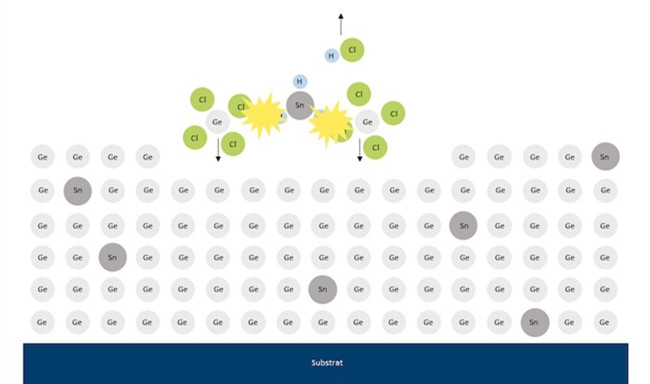[ Instrument R & D of Instrument Network ] For a long time, researchers have been looking for a method to directly integrate laser light into silicon chips, so that electronically operated transistors can use light to transmit data faster. Now, researchers from Fuchsentrum, France, and the teams of the Paris Nanoscience and Technology Center (C2N), STMicroelectronics and CEA-LETI Grenoble have developed a compatible semiconductor made of germanium and tin The efficiency of the laser is comparable to traditional GaAs semiconductor lasers on silicon.

Production of high-concentration germanium-tin compounds for CMOS production
Compared with current electronic processes, optical data transmission can achieve higher data rates and ranges, and uses less energy. Therefore, most current data centers use fiber optics by default. In the future, due to the increasing requirements for data transmission between chips, the demand for short-range optical solutions will continue to grow. A large amount of data must be transmitted in a large network in order to be used for training algorithms, which is more suitable for emerging technology fields. Such as artificial intelligence (AI) systems.
The researchers explained: "The most critical component missing is an inexpensive laser, which is necessary to achieve high data rates. An electric pump laser compatible with silicon-based CMOS technology would be ideal, such a laser can then be on-chip Simple forming in the manufacturing process, because the entire chip production is ultimately based on this technology. However, pure silicon is an indirect semiconductor and is not suitable for use as a laser material. Currently, different materials are used to manufacture laser-III-V Compound semiconductors, except that their lattice structure is completely different from silicon. Silicon is a fourth type of element. Laser components are currently manufactured externally and must be integrated later, which makes this technology very expensive. "
In contrast, the new germanium-tin-based laser newly developed by the researchers can be manufactured in the CMOS production process. Like silicon, it is also based on two four groups of elements. However, high tin content will reduce the laser efficiency, so at 12-14% tin content, a relatively high pump power of about 100-300 kW / cm2 is required. Therefore, the research team tried to reduce the tin concentration and passed Additional stress is applied to the material to compensate for this, thereby improving optical performance.
At the same time, for this new type of laser, the researchers reduced the tin content to about 5%, which reduced the pumping power to 0.8kw / cm ~ 2. The waste heat generated is very small and can be used as a continuous wave laser. These values ​​indicate that the germanium-tin laser is technically feasible, and its efficiency is comparable to that of traditional III-V semiconductor lasers grown on silicon, which also makes it closer to industrial electric pump lasers operating at room temperature. The potential applications of this new germanium-tin based laser in the future can range from infrared and night vision systems to gas sensors for environmental monitoring.
Dog Biscuit Process,Dog Biscuit Machine,Dog Biscuit Production Line,Dog Food Biscuits Making Machine
JINAN CFC MACHINERY CO.,LTD , https://www.cfcmachine.com